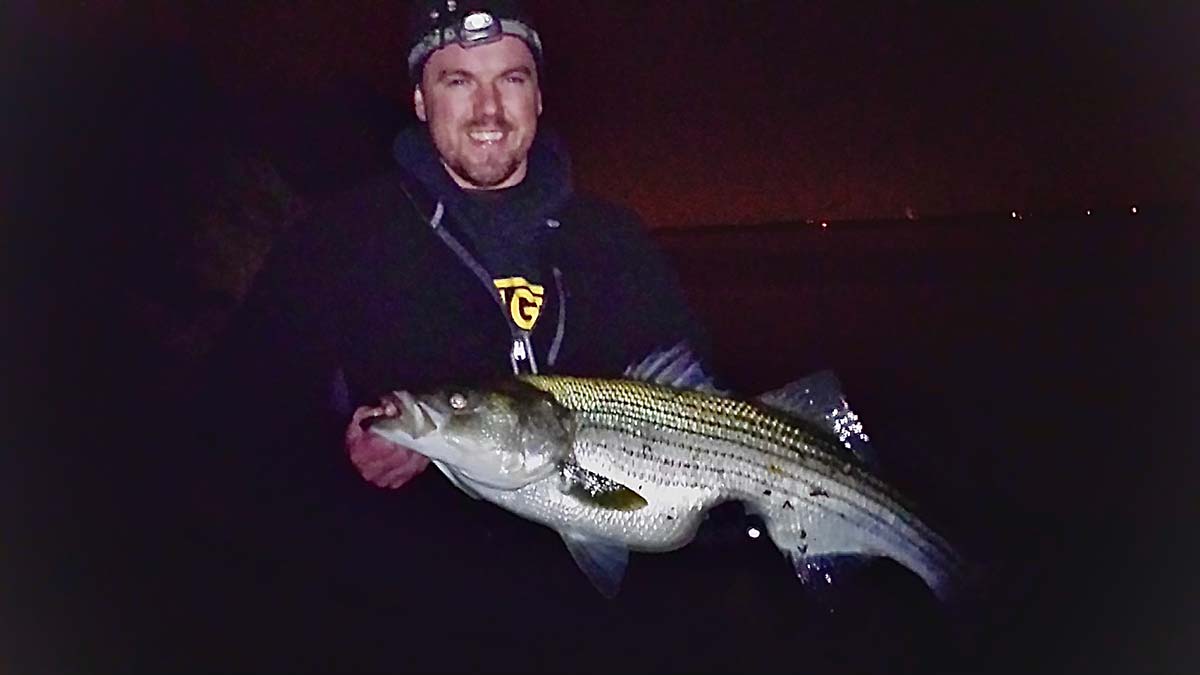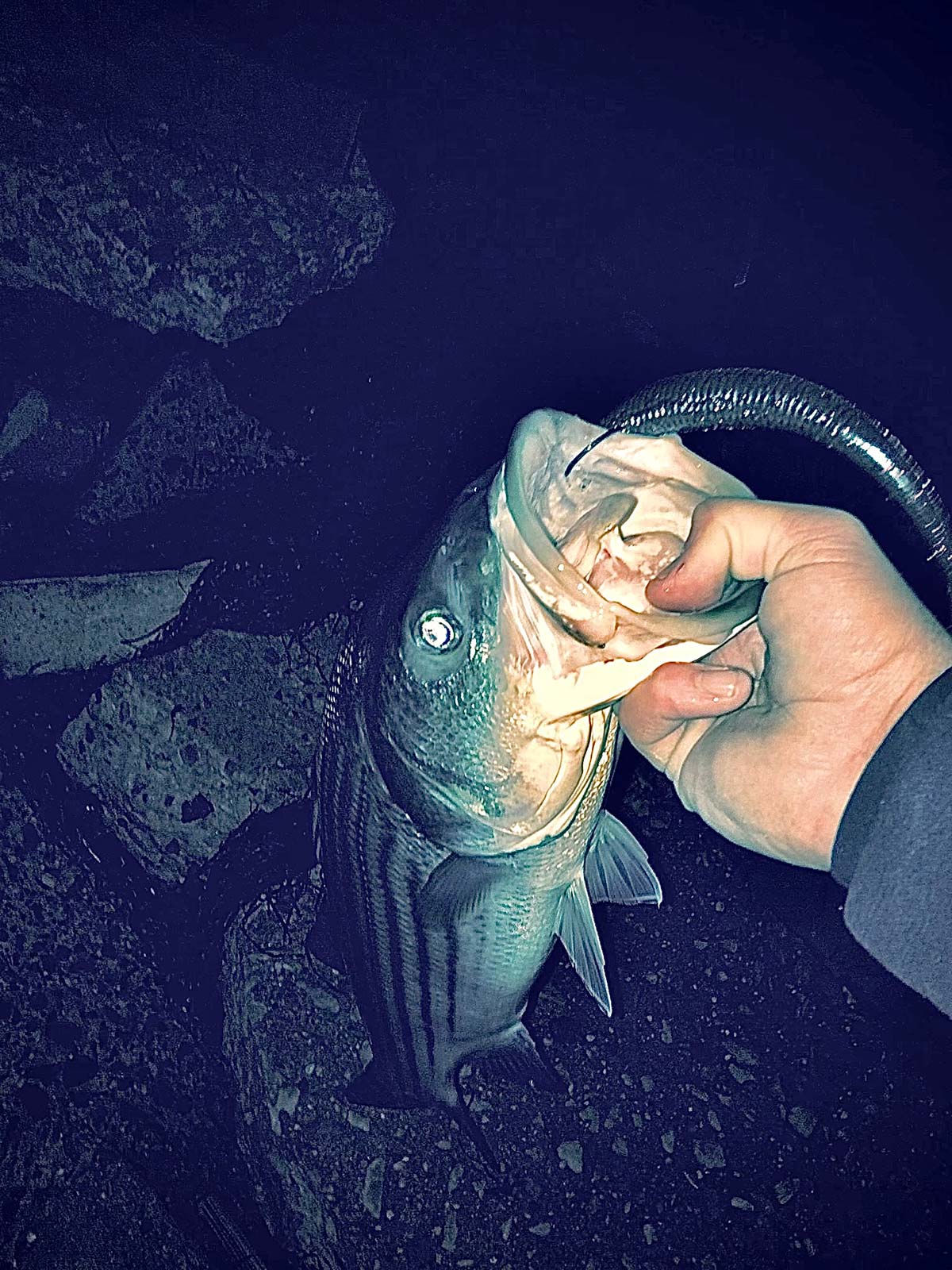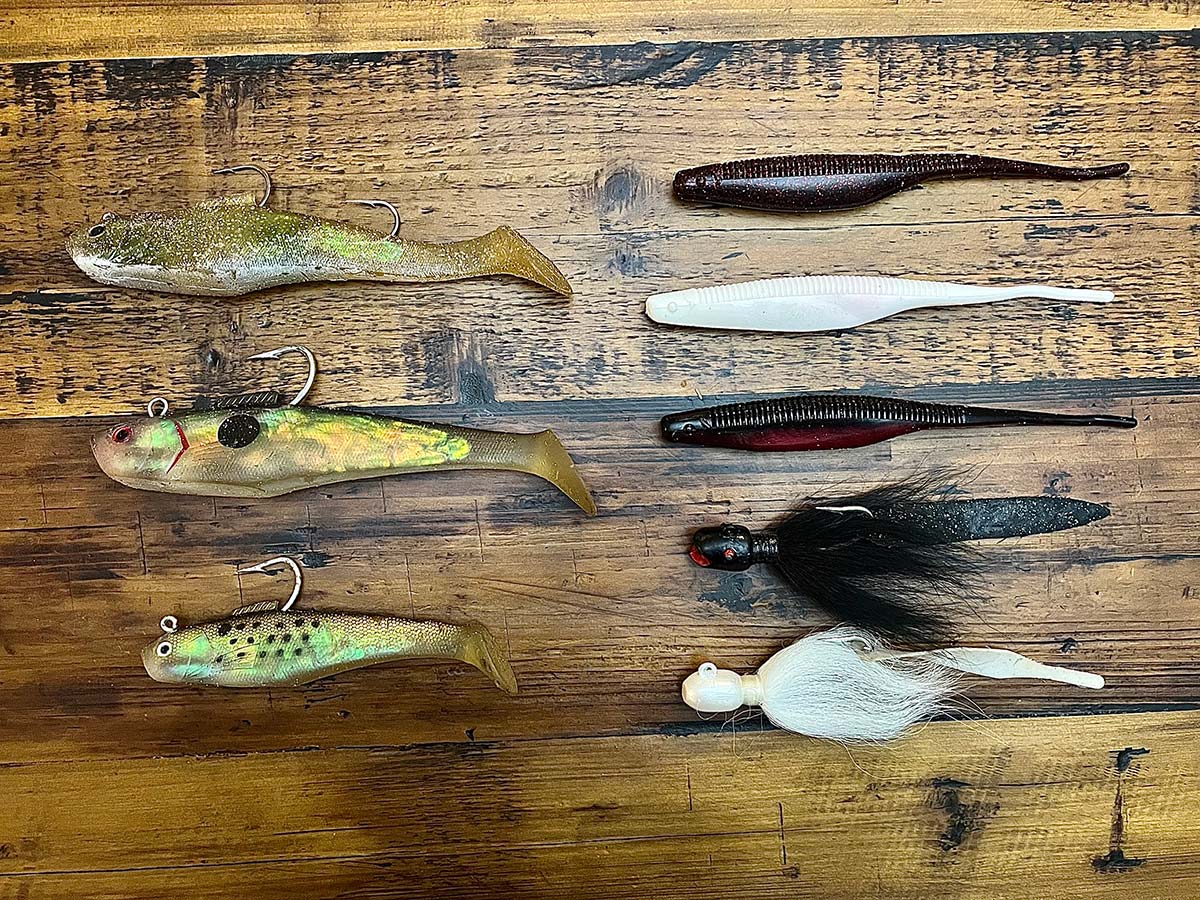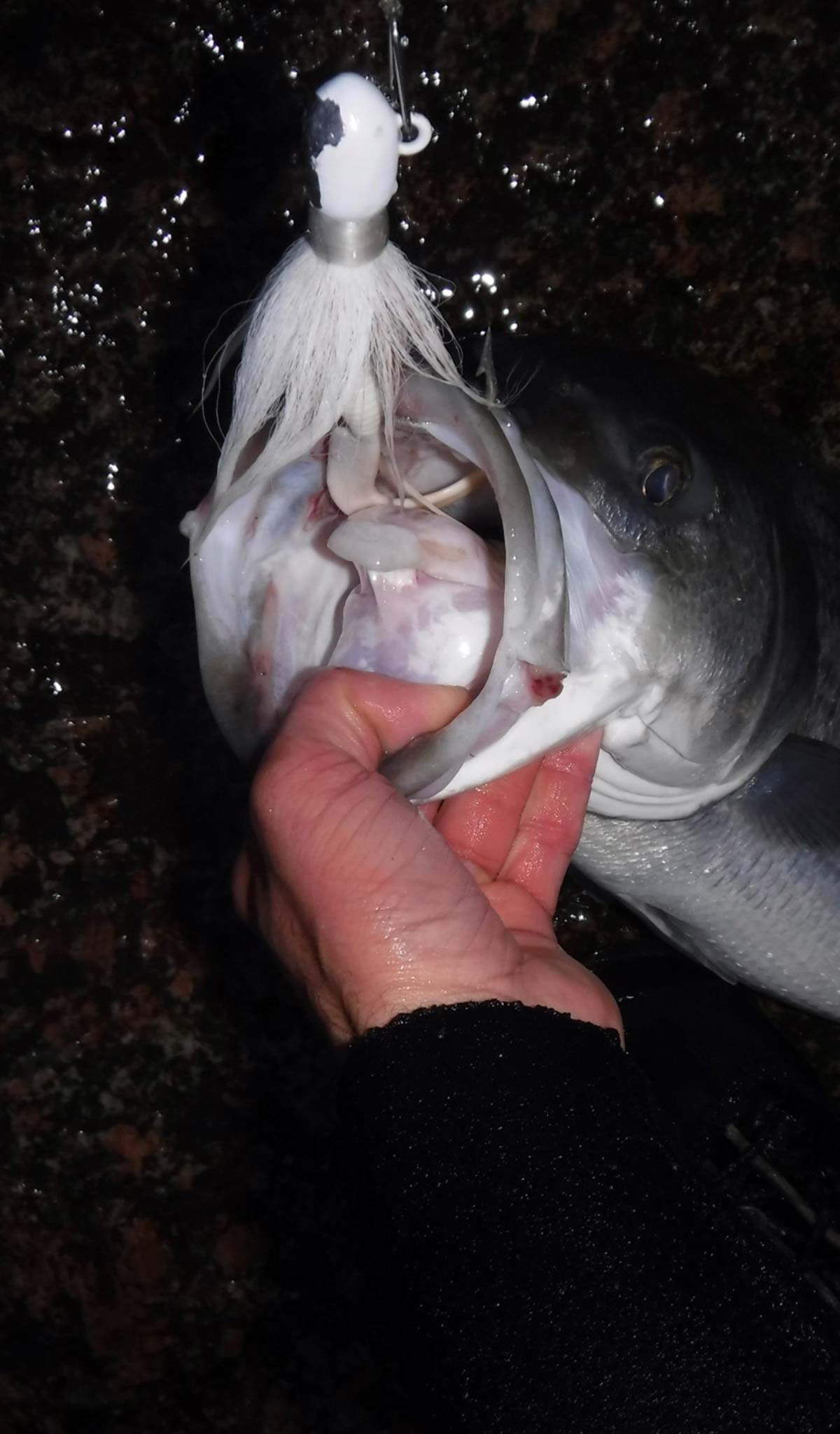
Take the time to put the puzzle together and figure it out.
As my bucktail settled toward the bottom of the water column and I picked up the slack, I could already sense the hit coming. As the 4-ounce jig swung past me at the 12 o’clock position to about 1 o’clock, I was greeted with that unmistakable tap of a bass hitting my jig. This exact scenario replayed itself five more times as the current slowed and eventually slacked off, at which time the bite died along with the tide. Fishing large bucktails and jigs in the deep, fast currents found in Long Island’s inlets is not for everyone, as it can be downright exhausting. Fortunately, often times this leads to smaller crowds at some prime locations. It was for this reason that I committed to learning the intricacies of fishing the deep fast waters of some of Long Island’s most popular and some not so popular inlets. And as I would soon learn the consistency and quality of fish I caught improved tremendously.
Tools Of The Trade
This type of fishing is not the place for those 9-foot light and medium power rods you see dominating the surf these days. You’ll want a rod in the 10 to 11-foot range with a medium heavy to heavy power and a moderate fast to fast action. My two primary setups consist of a 10 -foot Lamiglas medium heavy GSB and an 11-foot Lamiglas medium heavy Super Surf 2G. Required casting distance and maximum jig size will usually determine if I go with the 10 or 11-foot rod. Also, if I have and elevated rock wall or something else limiting the space behind me, I’ll fish the 10 foot. When distance is a factor I’ll usually opt for the 11. As for reels, I fish either a Van Staal VSX 275 or a Penn 706z. Both reels are spooled with 50-pound test braid, either Power Pro or Spiderwire. My leader consists of a quality barrel swivel in the 200-pound range, about 3 feet of 50 to 80-pound leader material, finished off with a Tactical Anglers Power Clip in the 125 or 175-pound size.
I avoid tying direct to my jig for two reasons: First to avoid cutting into my leader length as I change jig sizes. Second is to save time. Some of these locations may have a small window of prime tide (30 minutes or less) and you don’t want to waste time retying as the current speed changes.

Loading Up
Now for the fun part — filling your plug or jig bag. This is where you can go overboard with the endless combinations of bucktails, trailers, jigheads and soft plastics. For bucktails, I prefer the smiling bill style in both white and black. I’ll carry a variety of sizes in the 1.5 to 6-ounce range, but a majority of the jigs I carry are in the 2 to 4-ounce range. For trailers, I’ll use both pork rind strips and some of the newer synthetic strips.
As far as soft plastics, I’ve settled on two types that work best for me. The first are the swim shad-style that are internally weighted and have a paddle tail. I’ll carry jigs from 6 to 9 inches and for simplicity I fish mostly the Tsunami swim shads. The next style is the 9-inch Mega Shad soft plastics fished on a jighead. For jigheads I use Kalins or Hogy, In the 1.5 to 4-ounce sizes. Similar to my bucktails, I generally have white or pearl and a black with some type of flake. Again, it’s easy to overload yourself with different sizes and colors but if you can narrow it down to mostly one or two colors or styles and then an extra “just in case” color or two you’ll be able to dramatically lighten your plug bag and build confidence in the jigs you decide to fish. There are plenty of other bucktail and soft plastic styles that are certainly effective, but these are just the styles that I have settled on that I have confidence fishing.

Presentation
Prior to my commitment to learning and fishing bucktails and other large jigs, the technique seemed intimidating and I wasn’t quite sure how and where to start. The simple answer is you want your jig to sweep down current keeping it as close to the bottom as possible — sometimes easier said than done.
First you’ll need the proper size jig — you’ll need to match your jig size to the depth you plan on fishing as well as the current speed. This can become a bit of a balancing act. If you’re unsure of approximately what size jig to start with, there’s nothing wrong with using a little bit of trial and error. The key is to fish a jig heavy enough to get you to the bottom before your jig sweeps past you, while also being able to glide as close to the near bottom strike zone as possible, without getting constantly snagged. If you have to reel in too fast to stay off the bottom, the tension will cause your jig to lift out of the strike zone, sometimes before it ever makes it to that productive water column where fish are holding.
My cast is usually in the 10 to 11 o’clock range. Then I’ll pick up any slack in my line and let my jig sink toward the bottom. As the jig nears the bottom you will feel additional resistance caused by the rocky, uneven inlet floor. Again I’ll pick up any slack that developed during the jigs fall by either taking a few cranks of my reel or sometimes by simply raising my rod. From here you’re just letting the jig sweep down current, only taking turns of the reel as needed or at a slow steady pace. Once the jig reaches about the 1 o’clock you have three options: the first is to burn the jig back in, cast and repeat. The next option is to continue a steady retrieve back up current, many times you will find bass holding closer to the jetty or rock wall, where the initial drop-off occurs. The last option involves paying out line and letting your jig settle back towards the bottom to extend your drift a little bit.
It’s important to not only keep a log of your fishing success but also the different stages of the tide and current direction and how it changes along with the duration of these different stages.

Locations And Tactics
With a majority of my surfcasting taking place in Suffolk County, the inlets I frequent the most are Shinnecock and Fire Island, with the latter getting the most of my attention. Growing up right over the bridge in West Islip, it made fishing and learning the Fire Island area a no brainer. The unique feature about Fire Island Inlet that differentiates it from some of Suffolk County’s more popular inlets is that unlike the others that are shorter, usually perpendicular cuts between the barrier islands. Fire Island Inlet is made up of two separate, somewhat parallel barrier islands that create a funneling effect as water flows into and out of the Great South Bay. This overlap of barrier islands essentially creates a supersized inlet. Throughout Fire Island Inlet are numerous rock walls, points, sand bars and drop-offs (some as deep as 80 feet), all leading to the mouth of the inlet, where you will find Democrat point to the south and the Sore Thumb to the north — two locations rich with surfcasting history(and for good reason). Regardless of which inlet I decide to fish, I’ll generally approach them the same.
I fish areas that offer bass breaks or rips in the current located near deeper water where they can position themselves to easily pick off helpless baitfish as they are swept down current. Along with visible rip lines, rock points and bends in jetty walls do a great job breaking up the current and usually create eddies on the backside of the points that fish will use to wait and pick off bait in the same manner as described above.
When the night is through and you’re walking off the jetty back to your buggy, and you can barely lift your rod to put it back in your rod holder because your shoulder is on fire from casting oversized jigs all night, this is a sign you fished the inlet right and put the right amount of time in. It definitely is not for everyone. But for those surfcasters that take the time to put the puzzle together and figure it out, they’ll consistently put themselves one cast away from that fish of a lifetime! Good luck and fish safe.


